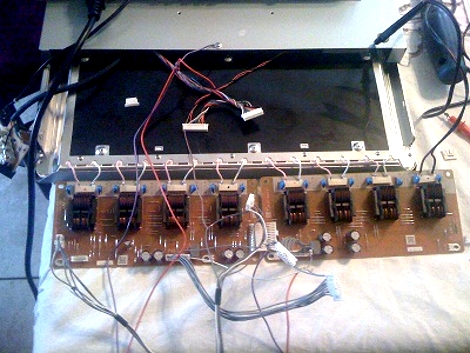
Another broken LCD TV came [Steve DiRaddo’s] way. This one had a broken backlight that he wanted to fix. He scrapped his LCD light table in order use the inverter. The two televisions were not the same size, nor made by the main manufacturer, but backlights all operate under the same principles. Using an inverter from a bit larger model meant it would have enough power to illuminate the lamps but he knew there’d be a problem with connectors and pinouts. After a bit of testing and creative wiring he got the system back up and running.
He’s got some extra parts left over from each TV including a bunch of CCFL lamps. Sound like it’s time to add some ground effects to his bike.















I don’t really understand what this is a picture of. Is this the connector? It looks to small to be the tv with a bunch of wires running across it.
I am in the process of fixing an eee pc backlight (had to remove the old one because im tabletizing it) by purchasing some usb strip lights that were described as “too bright” by reviewers. my initial tests show they work great! much easier than all the nonsense I see around the web.
@hum4n now THAT is a great idea! look for “too bright” in the reviews! I love it! Good luck with the EEE :)
I have to think up a neat project for the CCFL tubes. They are 28″ long!
@hum4n got a link for strips?
In order to spread the wisdom I’ll tell how I fixed two backlights. One had a bad fuse which I jumpered (it would have been better to replace the fuse but at least it wasn’t the main one on the power supply). The fuse was surface mount but easy to spot. The other display would come on for one second and then turn back off. I connected a 100 ohm resistor to ground and started poking testpoints on the circuit board. One test point (labelled ‘enable’) caused it to reset and come on for one second again. I hit this point repeatedly while jumpering each of the solder jumper points with another 100 ohm resistor until I found one that would make the display stay on permanently. My thinking was that these solder jumpers were put there because the engineers didn’t know whether that part should be connected or not (probably not the case, but it gave something to go on). After soldering it in place I found it only worked when I was touching it (my other hand was on the other resistor which was grounded) so I put in a 50k ohm resistor to ground. Maybe I disabled a safety mechanism, maybe something just wasn’t right with the circuit, who knows. This was a Samsung TV and it has been working for several months with no problems other than one of the bulbs being slightly dimmer than the rest.
@Dan
I once saved a lot of poking time after I was able to find the datasheet of that backlight controller.
respect, for making it work.
however having been in the service business,
it’s usually more efficient to order the service
manual on the specific model of set you’re doing
a repair on. it may even include alignment steps
needed to restore 100% oem functionality.
should go without saying, but don’t ever hit one of those inverters when they are powered. Your hand will go numb to the wrist if you are lucky.
just say No to high voltage.
Done this myself. Wasn’t so hard!
I just stole the driver from a cheap “pimp” your computer cold cathode. And used that one.
another worthwhile trick is to make a test jig out of an old CCFL inverter with each common type of connector to make sure the tube(s) ar working.
i also noticed that in many cases one of the backlight transformers has an open secondary, causing the whole inverter to shut down.
the fix is to replace the transformer with a compatible one and make sure that the light is even and nothing overheats.
I had this problem on an acer aspire one, I dissassembled the screen and soldered some backlight leds to energy points at the screen circuit,and backlight turned on again but I have an little issue with this, I had to add a little switch in order to turn on/off the backlight when I need to use this netbook, at least I didn’t need to buy a new lcd screen, Im newbie at this so I couldnt replace any component just powering directly the backlight leds through soldered wires